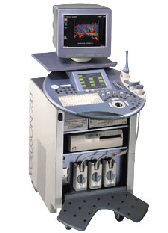Medical Ultrasound Imaging
Sunday, 19 May 2024
'Power Doppler' p3 Searchterm 'Power Doppler' found in 34 articles 4 terms [ • ] - 30 definitions [• ] Result Pages : •  From GE Healthcare.;
From GE Healthcare.;'GE is defining a new age of ultrasound. We call it Volume Ultrasound. GE's Voluson 730 Expert is a powerful system that enables real-time techniques for acquiring, navigating and analyzing volumetric images so that you can make clinical decisions with unprecedented confidence.'
Device Information and Specification
APPLICATIONS
Abdominal, breast, cardiac, musculoskeletal, neonatal, OB/GYN, pediatric, small parts, transcranial, urological, vascular
CONFIGURATION
15' high resolution non-interlaced flat CRT, 4 active probe ports
B-mode, M-mode, coded harmonic imaging (2-D), color flow mode (CFM), power Doppler imaging (PDI), color Doppler, pulsed wave Doppler, high pulse repetition frequency (HPRF) Doppler, tissue harmonic imaging, 3-D power Doppler
IMAGING OPTIONS
CrossXBeam spatial compounding, coded excitation , spatio-temporal image correlation (STIC), B-Flow (simultaneous imaging of tissue and blood flow), strain rate imaging (SRI)
OPTIONAL PACKAGE
STORAGE, CONNECTIVITY, OS
SonoView archiving and data management, network, HDD, DICOM 3.0, CD/DVD, MOD, USB, Windows-based
DATA PROCESSING
Digital beamformer with 512 system processing channel technology
H*W*D m (inch.)
1.43 * 0.69 * 1.02 (56 * 27 * 40)
WEIGHT
136 kg (300 lbs.)
•
In 3D ultrasound (US) several 2D images are acquired by moving the probe across the body surface or rotating inserted probes. 3D-mode uses the same basic concept of a 2D ultrasound but rather than take the image from a single angle, the sonographer takes a volume image. The volume image that is displayed on the screen is a software rendering of all of the detected soft-tissue combined by specialized computer software to form three-dimensional images. The 3D volume rendering technique (VR) does not rely on segmentation (segmentation techniques are difficult to apply to ultrasound pictures) and makes it possible to obtain clear 3D ultrasound images for clinical diagnosis. A 3D ultrasound produces a still image. Diagnostic US systems with 3D display functions and linear array probes are mainly used for obstetric and abdominal applications. The combination of contrast agents, harmonic imaging and power Doppler greatly improves 3D US reconstructions. 3D imaging shows a better look at the organ being examined and is used for:
•
Detection of abnormal fetus development, e.g. of the face and limbs.
•
Visualization of e.g. the colon and rectum.
•
Pictures of blood flow in various organs or a fetus.
Fusion 3D imaging methods for generating compound images from two sets of ultrasound images (B-mode and Doppler images) enable the observation of the structural relationships between lesions and their associated blood vessels in three dimensions (maximum intensity projection). Further Reading: News & More:
•
(CPA) Color power angio is a Doppler measurement, which employs the Doppler effect to assess whether blood is moving towards or away from the probe. By calculating the frequency shift of a particular sample volume, its speed and direction can be determined and visualized. This is particularly useful in cardiovascular studies and essential in many areas such as determining reverse blood flow in the liver vasculature in portal hypertension. The CPA information is displayed as a color image superimposed on the 2D gray scale image. See also Color Power Doppler. •
Contrast agents improve the sensitivity of vascular Doppler ultrasound, for example in cerebrovascular sonography or examinations of deep abdominal vessels. They also enlarge the role of transcranial Doppler. Microbubbles can be used with various modes e.g., color and power Doppler imaging, as well as pulsed-wave Doppler to increase the signal intensity. However, the ultrasound system must be suitable for contrast enhanced technology. Microbubbles usually stay within the vascular space; nevertheless, the contrast enhancement is limited to 2−6 minutes caused by physiologic clearance and bubble destruction. Depended on the application, contrast agents can be administered with a different injection rate e.g., bolus injection, slow injection, or continuous infusion. Stable, homogeneous, and prolonged enhancement can be obtained with perfusion, lasting until the infusion is stopped. See also Cerebrovascular Ultrasonography, Multiple Frame Trigger. •
Color assignments can be switched on any ultrasound system and are used as directional indicators. The colors of red and blue indicates flow direction in color Doppler. Red is encoded to represent flows toward the transducer. Blue pixel encoding is used to depict flows away from the transducer. See also Directional Color Power Doppler. Result Pages : |
Medical-Ultrasound-Imaging.com
former US-TIP.com
Member of SoftWays' Medical Imaging Group - MR-TIP • Radiology TIP • Medical-Ultrasound-Imaging
Copyright © 2008 - 2024 SoftWays. All rights reserved.
Terms of Use | Privacy Policy | Advertise With Us
former US-TIP.com
Member of SoftWays' Medical Imaging Group - MR-TIP • Radiology TIP • Medical-Ultrasound-Imaging
Copyright © 2008 - 2024 SoftWays. All rights reserved.
Terms of Use | Privacy Policy | Advertise With Us
[last update: 2023-11-06 01:42:00]




